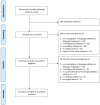Epilepsy and Bilingualism. A Systematic Review
- PMID: 31849811
- PMCID: PMC6893901
- DOI: 10.3389/fneur.2019.01235
Epilepsy and Bilingualism. A Systematic Review
Abstract
Background: In patients with epilepsy, language abilities and neural language organization have been primarily investigated for the patient's mother tongue. However, in clinical practice, many patients use more than one language or use their second language more than their mother tongue. Yet, information about the linguistic profiles and brain organization of both languages in bilingual epilepsy patients is scarce. The purpose of this study was thus to systematically review the literature on language localization and language abilities in bilingual patients with epilepsy. Methods: An extensive literature search was performed using various electronic databases, including Embase and Medline. Key aspects of inclusion criteria were the assessment of language abilities and/or the investigation of neural language mapping in bilingual patients with epilepsy. Results: Our search strategy yielded 155 articles on language in bilingual epilepsy patients. Of these, 12 met final eligibility criteria. The majority of included articles focused on brain mapping of language using fMRI, Wada-test, or electrocortical stimulation in bilingual epilepsy patients, five studies investigated interictal language abilities in this patient group. Study results showed a pronounced heterogeneity of language abilities in bilingual patients, varying from intact language profiles to impairment in several language functions in both languages. However, the mother tongue was most often better perserved than the second language. Furthermore, studies on brain mapping of both languages again revealed heterogeneous findings ranging from identical brain regions for both languages to overlapping, but more distributed cortical areas for the non-native language. Conclusions: This review underlines the need to evaluate linguistic abilities in both languages, as well as the necessity to preoperatively map both languages in bilingual epilepsy patients. In contrast to the large scientific interest in language abilities and language localization in monolingual epilepsy patients, this review shows that in bilingual patients, the examination of language functions and the identification of brain regions associated with both languages so far played a minor role in epilepsy research. Our review thus emphasizes the need of future research activities in this field.
Keywords: bilingualism; epilepsy; functional imaging; language localization; language proficiency; second language acquisition; seizures.
Copyright © 2019 Bartha-Doering and Bonelli.
Figures
References
-
- European_Commission Europeans and Their Languages. (2012). Available online at: https://ec.europa.eu/commfrontoffice/publicopinion/archives/ebs/ebs_386_... (accessed November 11, 2019).
Publication types
Grants and funding
LinkOut - more resources
Full Text Sources
Miscellaneous


